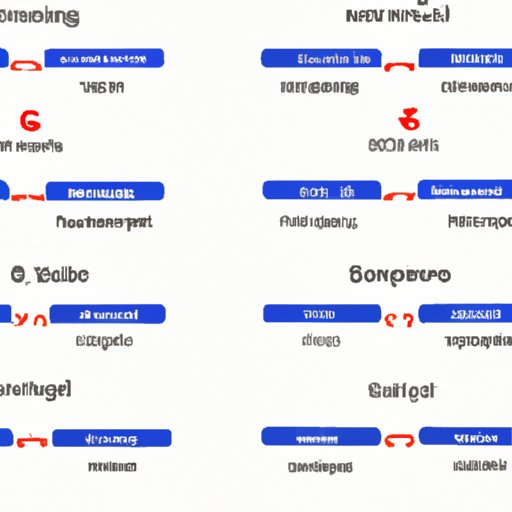Introduction
Search engines are essential tools for navigating the internet. But have you ever stopped to think about how they work? In this article, we’ll dive into the anatomy of a search engine and explore the complex process that powers search engine results. We’ll look at the different types of search engines, examine the algorithms used by each, and investigate the role of SEO in search engine performance.

Exploring the Anatomy of a Search Engine: A Comprehensive Guide
At its most basic level, a search engine is a program designed to help users find information on the web. It does this by using a combination of web crawlers and algorithms to locate and deliver relevant results. But what exactly does that mean? Let’s take a closer look at the components of a search engine and understand the roles of each in the search process.

Understanding the Components of a Search Engine
The anatomy of a search engine can be broken down into three main components: the web crawler, the indexer, and the query processor. The web crawler is responsible for finding and retrieving web pages for the search engine’s index. The indexer then organizes and stores all of the data gathered by the web crawler. Finally, the query processor retrieves and ranks web pages based on user queries.
Examining the Roles of Each Component in the Search Process
The web crawler, or “spider,” is responsible for gathering the data that the search engine uses to create its index. It follows links on web pages to find new content and adds it to the search engine’s index. The indexer then organizes and stores all of the data gathered by the web crawler. This includes information such as page titles, headings, keywords, and other data that helps the search engine understand the content of a web page.
Finally, the query processor takes user queries and searches the search engine’s index for relevant results. It then ranks these results based on factors such as relevance, popularity, and quality. The query processor also determines which ads should be displayed alongside the search results.
Understanding the Basics of How Search Engines Work
Now that we’ve explored the components of a search engine, let’s take a look at how they all come together to power the search process. There are two main steps involved in the search process: query processing and indexing. First, the query processor takes the user query and searches the search engine’s index for relevant results. Then, the indexer ranks the results based on factors such as relevance, popularity, and quality.
Investigating the Roles of Query Processing, Indexing, and Ranking
Query processing is the first step in the search process. It involves taking the user query and searching the search engine’s index for relevant results. The query processor looks for matches between the query and the data in the index. If it finds a match, it will return the result to the user.
Indexing is the second step in the search process. It involves organizing and storing the data gathered by the web crawler. This data is then used by the query processor to determine which results are most relevant to the user query. Finally, the indexer ranks the results based on factors such as relevance, popularity, and quality.

Comparing Different Types of Search Engines and Their Processes
Not all search engines are created equal. There are two main types of search engines: web-based search engines and enterprise search engines. Web-based search engines are the type of search engines most people are familiar with, such as Google and Bing. Enterprise search engines are designed specifically for businesses, and are often used to search large datasets for specific information.
The algorithms used by different search engines vary depending on their type. Web-based search engines use algorithms that prioritize relevance, while enterprise search engines use algorithms that prioritize speed and accuracy. Additionally, web-based search engines tend to rely more heavily on artificial intelligence (AI) to improve their results.
Analyzing the Algorithms Behind Search Engine Results
Search engine algorithms are complex and constantly evolving. They take into account numerous factors when determining the rankings of search engine results, such as the relevance of the content, the authority of the website, and the popularity of the content. Additionally, user experience plays an important role in search engine rankings. For example, if a user clicks on a result and then quickly returns to the search page, the search engine may infer that the result was not relevant and adjust its rankings accordingly.

Examining How Search Engines Crawl and Index Web Pages
In addition to understanding the algorithms behind search engine results, it’s important to know how search engines crawl and index web pages. Search engines use robots.txt files to identify which pages they should and should not crawl. Additionally, sitemaps provide search engines with information about the structure of a website, which can help them crawl and index web pages more efficiently.
Investigating the Role of SEO in Search Engine Performance
Search engine optimization (SEO) is the process of optimizing a website to improve its visibility in search engine results. SEO involves a variety of tactics, such as keyword research, link building, and content optimization. By utilizing these tactics, businesses can improve their search engine rankings and increase their visibility in search engine results.
Conclusion
Understanding how search engines work is essential for anyone looking to optimize their website and improve their search engine performance. From understanding the components of a search engine to analyzing the algorithms behind search engine results, this article has provided a comprehensive guide to the anatomy of a search engine. To improve your search engine performance, focus on optimizing your website for SEO and ensure that your website is properly indexed by search engines.
(Note: Is this article not meeting your expectations? Do you have knowledge or insights to share? Unlock new opportunities and expand your reach by joining our authors team. Click Registration to join us and share your expertise with our readers.)
